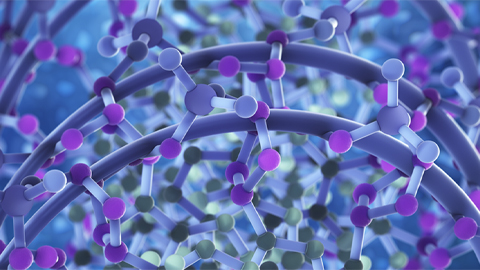From the journals: JBC
Enzyme activity in a crowd. Can nerves be made to regenerate? Preventing bacteria from sensing each other. Read about papers on these topics recently published in the Journal of Biological Chemistry.
Enzyme activity in a crowd
Macromolecular crowding, or an increase in concentrations of proteins and nucleic acids, can occur when limited water is available or a cell’s volume is reduced. These cramped conditions can affect protein–protein interactions, protein–DNA interactions and rates of biochemical reactions. In addition, many enzymes behave differently in a laboratory compared to their native conditions of molecular crowding in living cells, particularly bacterial cells.

In a recent paper in the Journal of Biological Chemistry, Zifang Deng and colleagues at the Florida International University describe how they examined the activity of Mycobacterium tuberculosis, or Mtb, DNA gyrase, the enzyme responsible for maintaining the negative supercoiling of double-stranded DNA, under conditions of macromolecular crowding. They treated cells with polyethylene glycols, or PEGs, and polyvinyl alcohols, or PVAs, to induce intracellular crowding, and then examined the activity of the DNA gyrase using enzymatic and gel-based assays. They then used molecular dynamics simulations to determine changes in the DNA gyrase structure.
These simulations showed that high PEG concentrations kept the gyrase in a closed or semiclosed conformation, keeping adenosine triphosphate ATP molecules trapped in a binding pocket, likely leading to the enhanced binding of ATP and DNA and increased efficacy and speed of DNA supercoiling activity.
The authors conclude that DNA gyrase activity increases under conditions of macromolecular crowding likely because water is excluded from hydrophobic interaction surfaces, which typically promotes tighter binding. Also, activity can increase due to steric repulsion, which limits the enzyme’s freedom to adopt additional conformations. The systematic and quantitative analysis of Mtb gyrase enzymatic activity highlights the importance of studying enzymes in their native environments, especially during stress, and could help inform research into drug strategies used to treat multidrug-resistant tuberculosis.
Can nerves be made to regenerate?
After a peripheral nerve injury, specialized glial cells of the peripheral nervous system called Schwann cells change from their mature, stable form to adopt a phenotype that can migrate to sites of injury and proliferate to promote nerve regeneration. Therefore, scientists have been seeking ways to activate the Schwann cell repair response as a clinical treatment for peripheral nerve injuries.
In a recent article in the Journal of Biological Chemistry, Qianqian Chen and colleagues at Nantong University in China describe their finding that the transcription factor FOS-like 1, or FOSL1, is highly expressed at sites of nerve crush. Using short interfering RNA that suppressed FOSL1 expression, chromatin immunoprecipitation and proliferation assays, the researchers showed that FOSL1 binds to the promoter of the tyrosine protein kinase receptor-encoding gene EPHB2 and induces its transcription; the Schwann cells then proliferate and migrate. Following this line of evidence, these authors demonstrated that EPHB2 increases the proliferation rate, movement direction and movement speed of Schwann cells.
The researchers found essential roles of FOSL1 and EPHB2 in the Schwann cell repair response and suggest they are potential therapeutic targets for treating peripheral nerve injury. Scientists will need to do additional studies to identify whether and how to target this signaling axis to promote nerve regeneration.
Preventing bacteria from sensing each other
A great struggle doctors and scientists face in fighting bacterial infections is using drugs without introducing selective pressure for those bacteria to develop drug resistance. One strategy to address this dilemma is developing molecules that affect bacterial quorum sensing, or QS, a process that allows bacteria to sense their population density and alter their gene expression once a quorum is reached.
In their new study published in the Journal of Biological Chemistry, Tahmina Milly and colleagues at the University of Nevada, Reno, explore the competence regulon QS circuitry in Streptococcus mitis, a commensal bacteria that would have pathogenic potential if it adopted virulence genes from the related bacteria S. pneumoniae. These authors used mutational scanning and circular dichroism spectroscopy to determine the structural motifs needed to bind the S. mitis competence-stimulating peptide to its receptor, and they even identified a peptide that could modulate QS in both S. mitis and S. pneumoniae.
These results demonstrate that the S. mitis competence regulon can modulate pathogenic phenotypes including biofilm formation. Using this QS-modulating scaffold, scientists can now further study the effects of temporal QS modulation in the natural bacterial environment and potentially find ways to inhibit bacterial competence.
Enjoy reading ASBMB Today?
Become a member to receive the print edition four times a year and the digital edition monthly.
Learn moreGet the latest from ASBMB Today
Enter your email address, and we’ll send you a weekly email with recent articles, interviews and more.
Latest in Science
Science highlights or most popular articles

Defining a ‘crucial gatekeeper’ of lipid metabolism
George Carman receives the Herbert Tabor Research Award at the ASBMB Annual Meeting, March 7–10, just outside of Washington, D.C.

The science of staying strong
Muscles power every movement, but they also tell the story of aging itself. Scientists are uncovering how strength fades, why some species resist it and what lifestyle and molecular clues could help preserve muscle health for life.

Bacteriophage protein could make queso fresco safer
Researchers characterized the structure and function of PlyP100, a bacteriophage protein that shows promise as a food-safe antimicrobial for preventing Listeria monocytogenes growth in fresh cheeses.

Building the blueprint to block HIV
Wesley Sundquist will present his work on the HIV capsid and revolutionary drug, Lenacapavir, at the ASBMB Annual Meeting, March 7–10, in Maryland.

Gut microbes hijack cancer pathway in high-fat diets
Researchers at the Feinstein Institutes for Medical Research found that a high-fat diet increases ammonia-producing bacteria in the gut microbiome of mice, which in turn disrupts TGF-β signaling and promotes colorectal cancer.

Mapping fentanyl’s cellular footprint
Using a new imaging method, researchers at State University of New York at Buffalo traced fentanyl’s effects inside brain immune cells, revealing how the drug alters lipid droplets, pointing to new paths for addiction diagnostics.

